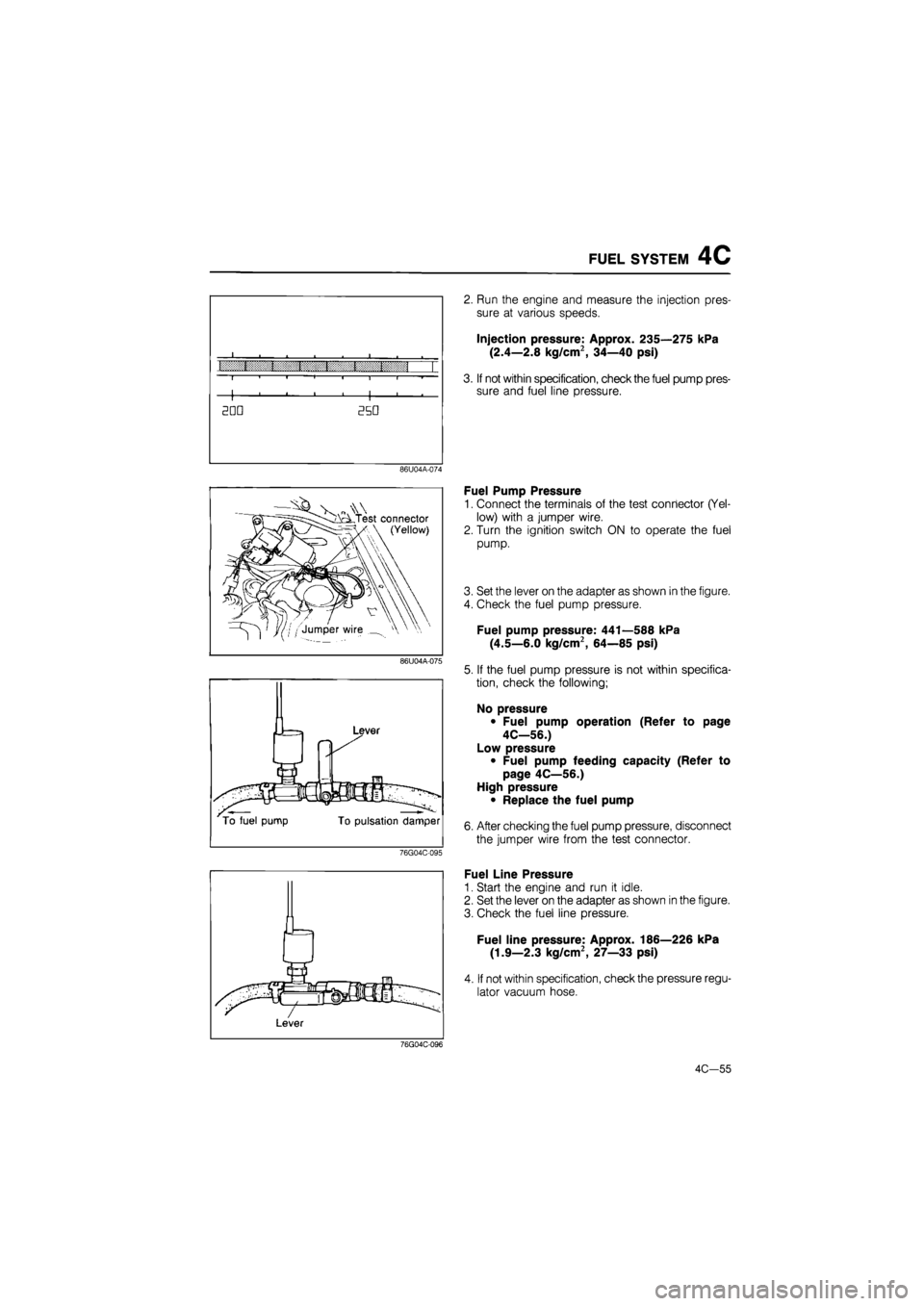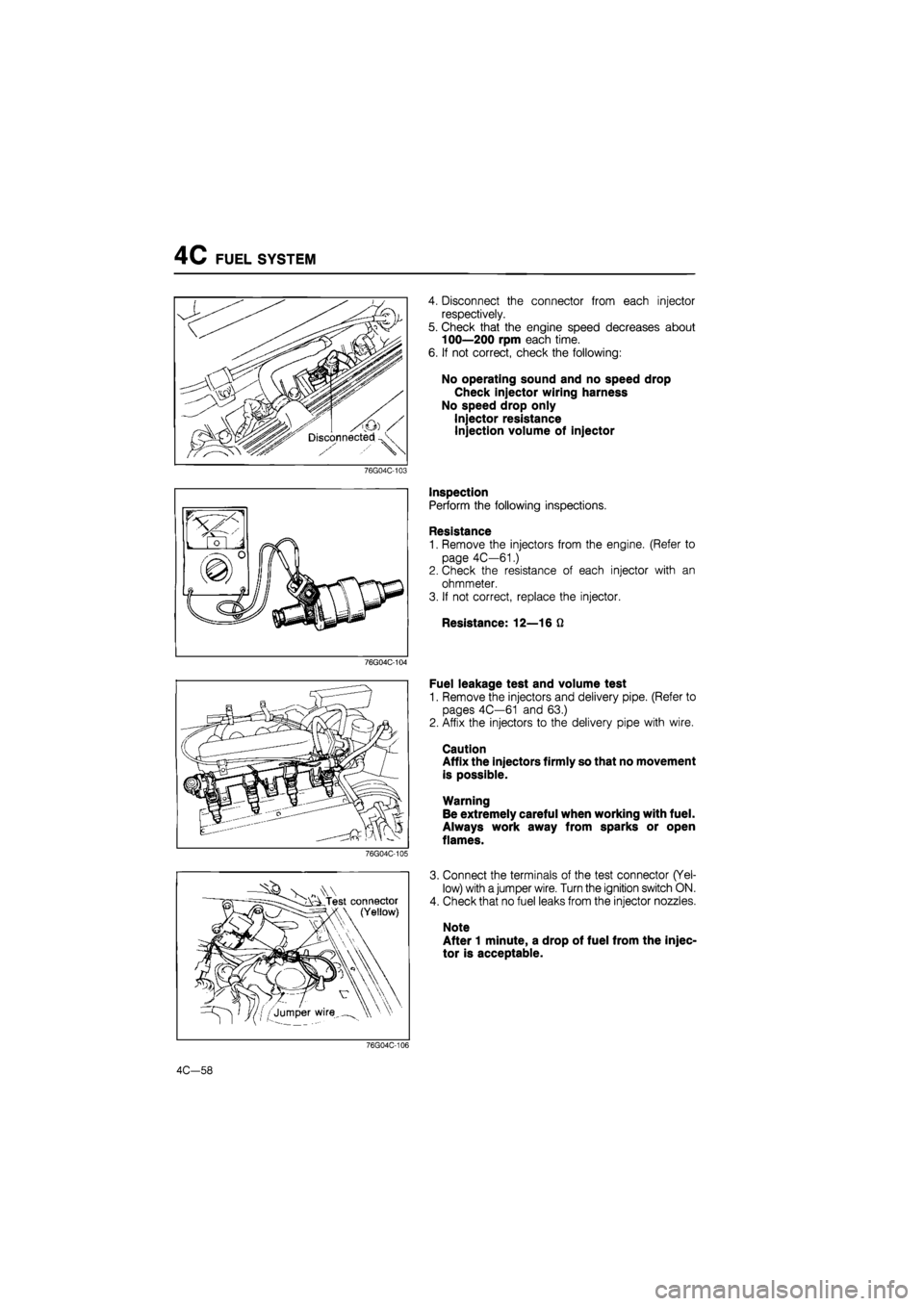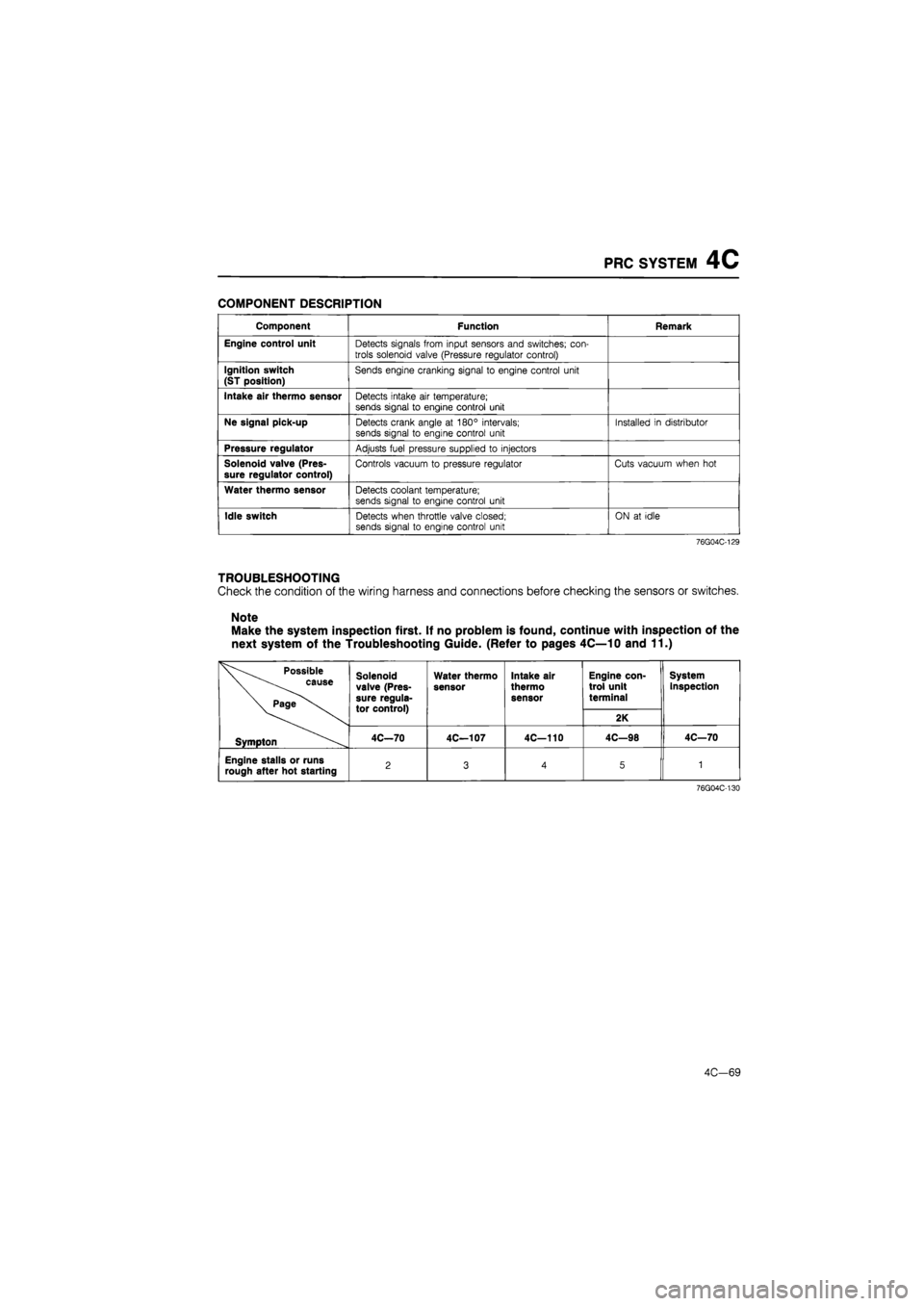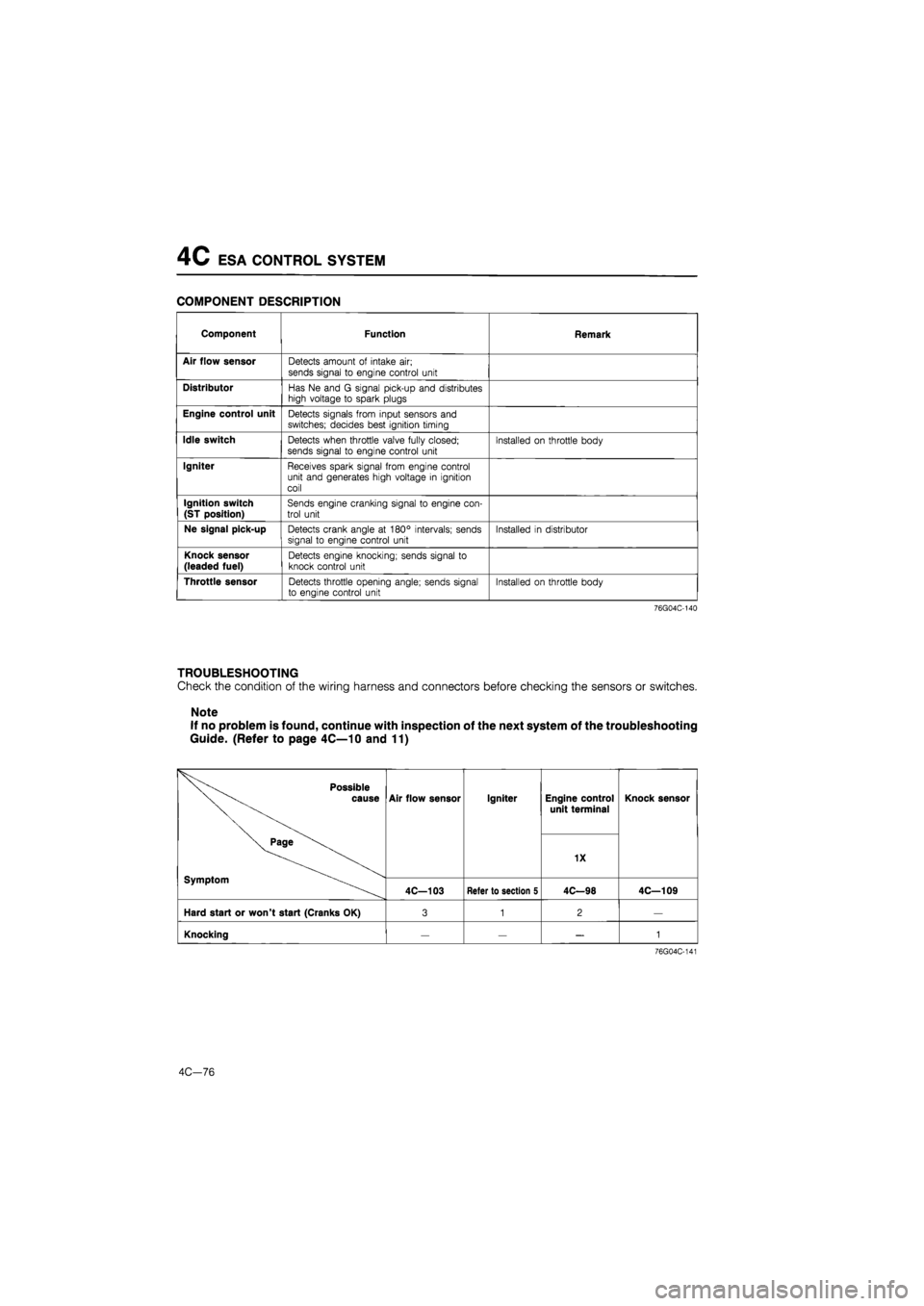ignition MAZDA 626 1987 Owners Manual
[x] Cancel search | Manufacturer: MAZDA, Model Year: 1987, Model line: 626, Model: MAZDA 626 1987Pages: 1865, PDF Size: 94.35 MB
Page 613 of 1865

4C FUEL SYSTEM
FUEL PRESSURE RELEASE AND SERVICING
FUEL SYSTEM
Fuel in the fuel system remains under high pressure
even when the engine is not running.
a) Before disconnecting any fuel line, release the fuel
pressure from the fuel system to reduce the pos-
sibility of injury or fire.
1. Start the engine.
2. Disconnect the 4-pin connector from the con-
trol relay or the fuel pump connector (5-pin or
6-pin).
3. After the engine stalls, turn OFF the ignition
switch.
4. Reconnect the relay or fuel pump connector.
b) Use a rag as protection from fuel spray when dis-
connecting the hoses.
Plug the hoses after removal.
c) When inspecting the fuel system, use the SST.
4C—52
Page 615 of 1865

4C FUEL SYSTEM
f-|To pulsation
-'damper
76G04C-092
Pressure regulator
How to Connect Multi-Pressure Tester
Warning
Before connecting the SST, release the fuel
pressure from the fuel system to reduce the
possibility of injury or fire. (Refer to page
4C—52.)
1. Disconnect the negative battery terminal.
2. Disconnect the fuel main hose from the fuel filter.
3. Connect the SST and adapter between the fuel
main hose and the fuel pump.
Caution
Do not reverse the adapter connection.
4. Disconnect the vacuum hose from the pressure
regulator. Connect the SST to the vacuum hose
with a three-way joint.
5. Connect the negative battery terminal.
6. Connect the SST to the battery.
76G04C-093
V „ Test connector (Yellow)
7. Connect the terminals of the test connector (Yel-
low) with a jumper wire. Turn the ignition switch
ON to operate the fuel pump.
8. Check for fuel leaks.
Caution
After checking for fuel leakage, turn the igni-
tion switch OFF and disconnect the jumper
wire from the test connector.
86U04A-072
FUEL PRESSURE
Note
Warm up the engine to normal operating tem-
perature.
Injection Pressure
1. Set the lever on the adapter as shown in the figure.
76G04C-094
4C-54
Page 616 of 1865

FUEL SYSTEM 4C
i i 1 1 1 i i
r.:.:::r t t t t t izn —i—i—i—i—i—i—i—i—
2DD 350
86U04A-074
2. Run the engine and measure the injection pres-
sure at various speeds.
Injection pressure: Approx. 235—275 kPa
(2.4—2.8 kg/cm2, 34—40 psi)
3. If not within specification, check the fuel pump pres-
sure and fuel line pressure.
Fuel Pump Pressure
1. Connect the terminals of the test connector (Yel-
low) with a jumper wire.
2. Turn the ignition switch ON to operate the fuel
pump.
3. Set the lever on the adapter as shown in the figure.
4. Check the fuel pump pressure.
Fuel pump pressure: 441—588 kPa
(4.5—6.0 kg/cm2, 64—85 psi)
5. If the fuel pump pressure is not within specifica-
tion, check the following;
No pressure
• Fuel pump operation (Refer to page
4C—56.)
Low pressure
• Fuel pump feeding capacity (Refer to
page 4C—56.)
High pressure
• Replace the fuel pump
6. After checking the fuel pump pressure, disconnect
the jumper wire from the test connector.
Fuel Line Pressure
1. Start the engine and run it idle.
2. Set the lever on the adapter as shown in the figure.
3. Check the fuel line pressure.
Fuel line pressure: Approx. 186—226 kPa
(1.9—2.3 kg/cm2, 27—33 psi)
4. If not within specification, check the pressure regu-
lator vacuum hose.
4C-55
Page 617 of 1865

4C FUEL SYSTEM
86U04A-078
76G04C-097
76G04C-098
„\W cLTest connector (Yellow)
'-/jumper wire \\ \ •
5. Disconnect the vacuum hose from pressure regu-
lator, and place a finger over the end of the hose.
6. Check the fuel line pressure.
Fuel line pressure: 235—275 kPa
(2.4—2.8 kg/cm2, 34—40 psi)
7. If not within specification, replace the pressure
regulator.
8. Connect the vacuum hose to pressure regulator.
FUEL PUMP
Operation Test
1. Connect a jumper wire to the test connector
(Yellow).
2. Remove the fuel filler cap.
3. Disconnect transfer pump connector (8-pin).
4. Turn the ignition switch ON.
5. Listen for operational sound of the fuel pump at
the filler inlet.
6. Install the fuel filler cap.
7. If no sound was heard, check the voltage at the
fuel pump connector (WY wire and a ground).
Voltage: 12V
8. If the voltage is normal, replace the fuel pump.
9. If not correct, check the control relay and circuit
(Refer to page 4C—96.)
10. Disconnect the jumper wire.
Volume Test
Warning
Before performing the following procedures,
release the fuel pressure from the fuel system
to reduce the possibility of injury or fire.
(Refer to page 4C—52)
1. Connect a jumper wire to test connector (Yellow).
2. Disconnect the fuel return hose from fuel return
pipe.
76G04C-099
4C-56
Page 618 of 1865

FUEL SYSTEM 4C
Pulsation damper
76G04C-100
Intake mainfold
3. Turn the ignition switch ON for 10 seconds, and
check the feeding capacity with graduated
cylinder.
Feeding capacity:
Minimum 220 cc (13.4 cu in)/10 sec.
4. If not within specification, check the fuel filter, fuel
lines and fuel pump.
5. Turn the ignition switch OFF and disconnect the
jumper wire.
PULSATION DAMPER
1. Run the engine at idle.
2. Place a finger on the screw of the pulsation damper
head.
3. Check that pulsation is felt.
86U04A-083
Injector
INJECTOR
On-vehicle Inspection
1. Warm up the engine and run it at idle.
2. Listen for operational sound of the injector with a
screwdriver or a sound scope.
76G04C-101
3. Ground the test connector (Green, 1-pin).
76G04C-102
4C-57
Page 619 of 1865

4C FUEL SYSTEM
76G04C-103
76G04C-104
76G04C-105
- s A Test connector I \ (Yellow)
4. Disconnect the connector from each injector
respectively.
5. Check that the engine speed decreases about
100—200 rpm each time.
6. If not correct, check the following:
No operating sound and no speed drop
Check injector wiring harness
No speed drop only
Injector resistance
Injection volume of injector
Inspection
Perform the following inspections.
Resistance
1. Remove the injectors from the engine. (Refer to
page 4C—61.)
2. Check the resistance of each injector with an
ohmmeter.
3. If not correct, replace the injector.
Resistance: 12—16 Q
Fuel leakage test and volume test
1. Remove the injectors and delivery pipe. (Refer to
pages 4C—61 and 63.)
2. Affix the injectors to the delivery pipe with wire.
Caution
Affix the injectors firmly so that no movement
is possible.
Warning
Be extremely careful when working with fuel.
Always work away from sparks or open
flames.
3. Connect the terminals of the test connector (Yel-
low) with a jumper wire. Turn the ignition switch ON.
4. Check that no fuel leaks from the injector nozzles.
Note
After 1 minute, a drop of fuel from the injec-
tor is acceptable.
76G04C-106
4C—58
Page 620 of 1865

FUEL SYSTEM 4C
5. Connect the SST to the battery and injector.
6. Check the injection volume with a graduated con-
tainer.
Injection volume:
Approx. 66—91 cc (4.03—5.55 cu in) /15 sec.
Caution
When using the SST, make sure of the SST
number and use correct one.
7. If not correct, replace the injector.
76G04C-107
Rear seat Cushion Release Button -
76G04C-108
TRANSFER PUMP CONTROL SYSTEM (4 WHEEL
STEERING)
1. Remove the rear seat. (Refer to 14 section.)
2. Remove the fuel filler cap.
3. Turn the ignition switch ON.
Note
a) The tank should be more than 1/3 full.
b) Due to the delay timer, transfer pump oper-
ation begins approx. 10 sec. after the igni-
tion switch is turned ON.
4. Listen for the operational sound of the transfer
pump.
5. Install the fuel filler cap.
6. If no sound was heard, check the voltage at the
transfer pump connector.
Terminal (wire) Voltage
A, C (WG) Approx. 12V
I, J (B) OV
86U04B-075
I C A
lb d
cp a • • •
J
76G04C-211
7. If the voltages are correct, replace the transfer
pump.
8. If not correct, disconnect the transfer pump con-
nector.
9. Check the voltage at the terminals below.
Terminal (wire) Voltage
A, C (WG) Approx. 12V
I, J (B) OV
10. If the voltages are correct, replace the transfer
pump.
4C—59
Page 630 of 1865

PRC SYSTEM 4C
COMPONENT DESCRIPTION
Component Function Remark
Engine control unit Detects signals from input sensors and switches; con-trols solenoid valve (Pressure regulator control)
Ignition switch
(ST position)
Sends engine cranking signal to engine control unit
Intake air thermo sensor Detects intake air temperature; sends signal to engine control unit
Ne signal pick-up Detects crank angle at 180° intervals; sends signal to engine control unit Installed in distributor
Pressure regulator Adjusts fuel pressure supplied to injectors
Solenoid valve (Pres-
sure regulator control)
Controls vacuum to pressure regulator Cuts vacuum when hot
Water thermo sensor Detects coolant temperature; sends signal to engine control unit
Idle switch Detects when throttle valve closed; sends signal to engine control unit ON at idle
76G04C-129
TROUBLESHOOTING
Check the condition of the wiring harness and connections before checking the sensors or switches.
Note
Make the system inspection first. If no problem is found, continue with inspection of the
next system of the Troubleshooting Guide. (Refer to pages 4C—10 and 11.)
Possible
\ cause
\ Page
Solenoid valve (Pres-sure regula-tor control)
Water thermo
sensor
Intake air
thermo
sensor
Engine con-trol unit terminal
System inspection Solenoid valve (Pres-sure regula-tor control) 2K
Symplon 4C—70 4C—107 4C-110 4C—98 4C—70
Engine stalls or runs rough after hot starting 2 3 4 5 1
76G04C-130
4C-69
Page 636 of 1865

ESA CONTROL SYSTEM 4C
ELECTRONIC SPARK ADVANCE
(ESA)
CONTROL SYSTEM
Throttle sensor
76G04C-139
This system electronically controls the ignition timing to obtain better engine performance.
The best ignition timing is determined and set within the engine control unit based on signals from
the various sensors and switches.
The knock control function is used only with leaded fuel engines.
4C-75
Page 637 of 1865

4C ESA CONTROL SYSTEM
COMPONENT DESCRIPTION
Component Function Remark
Air flow sensor Detects amount of intake air;
sends signal to engine control unit
Distributor Has Ne and G signal pick-up and distributes high voltage to spark plugs
Engine control unit Detects signals from input sensors and switches; decides best ignition timing
Idle switch Detects when throttle valve fully closed; sends signal to engine control unit Installed on throttle body
Igniter Receives spark signal from engine control unit and generates high voltage in ignition coil
Ignition switch
(ST position) Sends engine cranking signal to engine con-trol unit
Ne signal pick-up Detects crank angle at 180° intervals; sends signal to engine control unit Installed in distributor
Knock sensor (leaded fuel) Detects engine knocking; sends signal to knock control unit
Throttle sensor Detects throttle opening angle; sends signal to engine control unit Installed on throttle body
76G04C-140
TROUBLESHOOTING
Check the condition of the wiring harness and connectors before checking the sensors or switches.
Note
If no problem is found, continue with inspection of the next system of the troubleshooting
Guide. (Refer to page 4C—10 and 11)
Possible cause
Page
Symptom
Air flow sensor Igniter Engine control
unit terminal Knock sensor Possible cause
Page
Symptom
Air flow sensor Igniter
1X
Knock sensor Possible cause
Page
Symptom
4C—103 Refer to section 5 4C—98 4C—109
Hard start or won't start (Cranks OK) 3 1 2 —
Knocking — 1
76G04C-141
4C-76